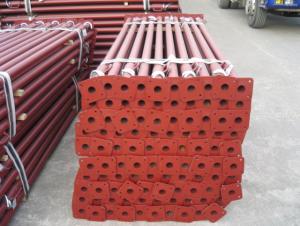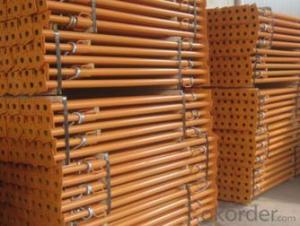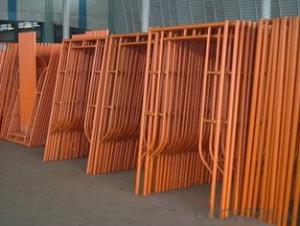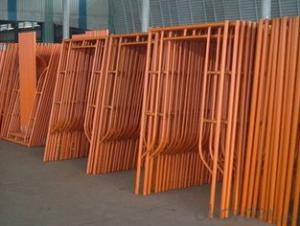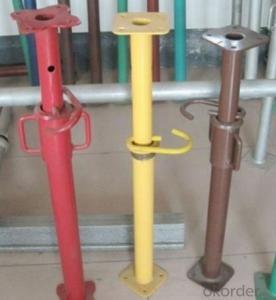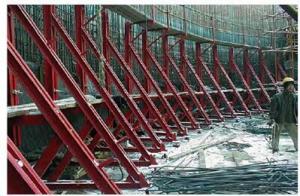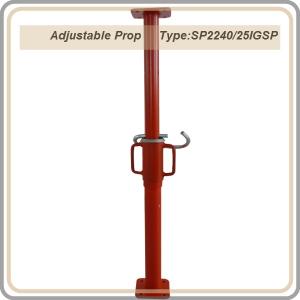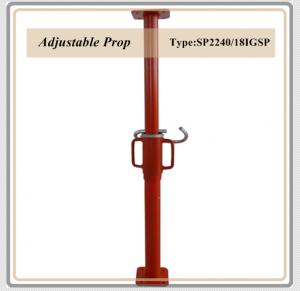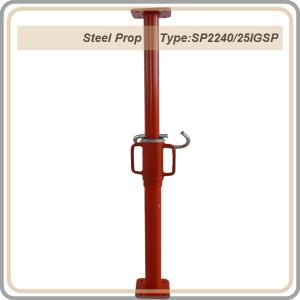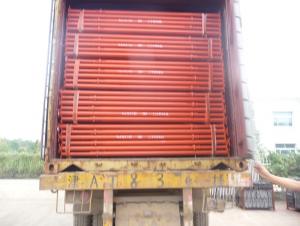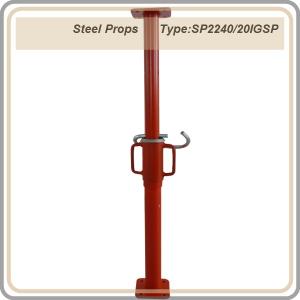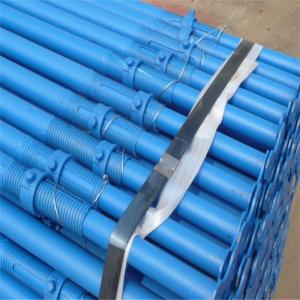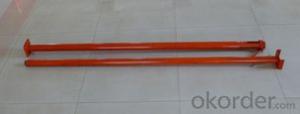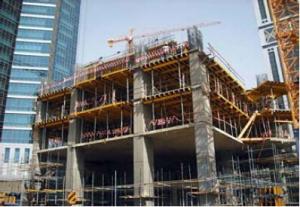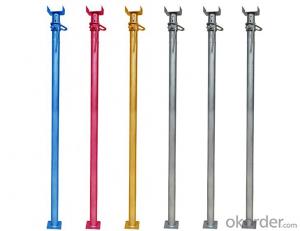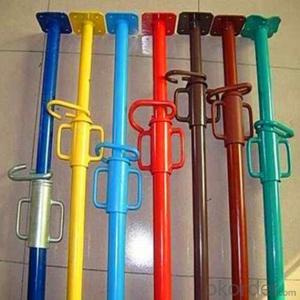Export Adjustable Props/ red color prop 2.2-4M
- Loading Port:
- China Main Port
- Payment Terms:
- TT or LC
- Min Order Qty:
- 1680 Piece/Pieces pc
- Supply Capability:
- 10000 pc/month
OKorder Service Pledge
OKorder Financial Service
You Might Also Like
Description
1. Length 2200-4000mm
2. Outer tube diameter 56mm
3. Inner tube diameter 48mm
4. Tube material : Q235
5. Tube thickness : 2.0mm
6. weight : 11kgs
7. square plate : 120*120*4mm
8. Italian type nut
9. G-pin 12
10. Painted surface
11. Color : as customer 's request . red / blue / green / orange/ brown
Packaging & Delivery
| Packaging Details: | packaging :50pcs / bale container : 1680pcs / 20ft |
|---|---|
| Delivery Detail: | 20-30days after receive deposit |
Specifications
Adjustable props / construction prop
Height 2.2-4M
Italy type painted props
Adjustable props
Shoring props
Construction scaffold steel prop
Scaffold props
Telescopic steel props
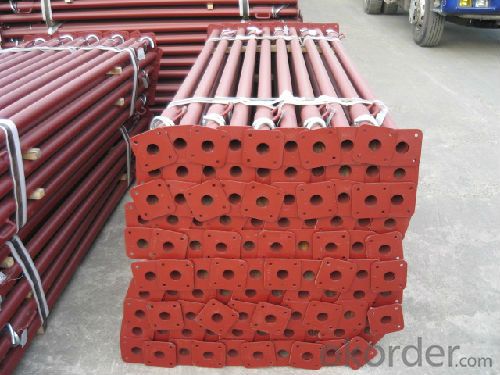

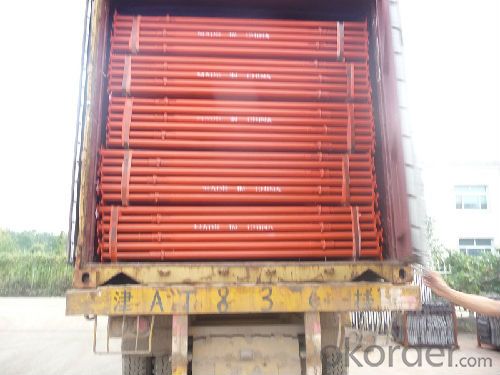
Product introduce
Steel Prop is a labour and time saving device to support shuttering and centering.
It is made outer tube of 60mm (O. D.) & inner pipe of 48mm (O. D.)
or outer tube 56mm (O.D.) & inner pipe 48mm (O.D.) ,
or outer tube 48mm (O.D.) & inner pipe 40 mm (O.D.) moving in each other telescopically.
The surface has painted , powder , electric galvanized and hot dipped galvanized .
The height use of props by double staging is recommended upto 7000mm only .
Top and bottom plate are provided with nail holes for wooden beam or steel beam .
The top has square shape , flower shape or U-head , U-fork head .
U-head can use fix or adjustable .
- Q: Can steel props be used in dam construction?
- Yes, steel props can be used in dam construction. Steel props provide strong support and stability during the construction process, ensuring the safety and structural integrity of the dam.
- Q: Can steel props be used in the construction of schools?
- Yes, steel props can be used in the construction of schools. Steel props are commonly used to support temporary structures during construction, including scaffolding, formwork, and falsework. They provide stability and strength to ensure the safety of the construction site and workers. In the case of school construction, steel props can be used to support various elements such as beams, columns, and floors, ensuring the structural integrity of the building.
- Q: Can steel props be used for bridge construction?
- Yes, steel props can be used for bridge construction. Steel props, also known as adjustable steel props or steel shore, are commonly used in construction projects to support temporary structures such as formwork, scaffolding, or falsework. They provide stability and load-bearing capacity during the construction phase. In bridge construction, steel props can be used to support various components of the bridge. For example, during the erection of bridge girders, steel props can be used to provide temporary support until the girders are properly secured. They can also be used to support formwork for casting bridge decks or other concrete elements. Steel props offer several advantages for bridge construction. Firstly, they are made of steel, which has high strength and durability, making them capable of withstanding heavy loads. Secondly, they are adjustable, allowing for precise height adjustments to accommodate different bridge construction stages and variations in ground levels. This adjustability makes them versatile and suitable for various bridge construction scenarios. Furthermore, steel props are easy to install, disassemble, and transport, making them a convenient choice for temporary support in bridge construction projects. They can be quickly adjusted and reused in different locations, saving time and cost during the construction process. However, it is important to note that steel props are typically used as temporary supports during construction and are not intended to be permanent load-bearing elements of the bridge structure. Once the bridge is completed, the steel props are removed, and the permanent support system takes over the load-bearing function. In conclusion, steel props can be effectively used for bridge construction as temporary supports. They provide stability, load-bearing capacity, and adjustability, making them a reliable choice for supporting various components of the bridge during the construction phase.
- Q: What are the safety precautions to consider when working with steel props?
- When working with steel props, there are several safety precautions that should be considered to ensure a safe working environment. 1. Proper training and instruction: It is important to have proper training and instruction on how to use steel props correctly. This includes understanding the manufacturer's guidelines, load capacities, and installation procedures. 2. Inspect before use: Before using steel props, they should be inspected for any signs of damage or wear. This includes checking for cracks, bends, or corrosion. If any defects are found, the props should not be used and should be replaced or repaired. 3. Use appropriate personal protective equipment (PPE): Workers should always wear the necessary PPE when working with steel props. This may include safety glasses, gloves, hard hats, and protective footwear. 4. Secure the props properly: Steel props should be securely fastened or anchored to prevent them from shifting or collapsing during use. This may involve using pins, bolts, or other appropriate fasteners. 5. Properly load and distribute weight: When using steel props to support loads, it is important to ensure that the weight is evenly distributed and within the recommended load capacity. Overloading steel props can cause them to fail, leading to potential accidents or injuries. 6. Avoid excessive movement or impact: Steel props should not be subjected to excessive movement or impact, as this can weaken their structural integrity. Proper care should be taken when handling and positioning the props to prevent any unnecessary stress or damage. 7. Regular maintenance and inspection: Steel props should be regularly inspected and maintained to ensure their safety and functionality. This includes cleaning, lubricating, and checking for any signs of wear or damage. By following these safety precautions, workers can minimize the risk of accidents or injuries when working with steel props. It is crucial to prioritize safety and adhere to proper procedures to create a secure working environment.
- Q: What is the average lifespan of a steel prop?
- The average lifespan of a steel prop can vary depending on various factors such as usage, maintenance, and environmental conditions. However, on average, a well-maintained and properly used steel prop can last anywhere between 5 to 10 years. Regular inspections, maintenance, and adherence to safety guidelines can help extend the lifespan of a steel prop. It is important to note that factors such as excessive load, improper storage, or exposure to harsh elements can significantly reduce the lifespan of a steel prop.
- Q: What are the common signs of wear or damage on steel props?
- The signs of wear or damage on steel props can vary depending on the type of prop and how it is used. However, there are some general indicators that can help detect potential issues: 1. Rust or corrosion: One common sign of wear on steel props is the presence of rust or corrosion. This can happen when the prop is exposed to moisture or chemicals, weakening the steel and compromising its load-bearing capacity. 2. Bent or twisted parts: Excessive loads or impacts can cause steel props to bend or twist. This affects the stability and strength of the prop, making it unsafe for further use. 3. Cracks or fractures: Another sign of wear or damage is the presence of cracks or fractures on the steel prop. These can be caused by fatigue or overloading, compromising the prop's structural integrity. 4. Loose or damaged fittings: Steel props often have various fittings, such as pins, bolts, or adjustable mechanisms, which can become loose or damaged over time. Regularly checking these fittings for signs of wear or damage is important to ensure proper functioning and stability. 5. Excessive wear on load-bearing surfaces: The baseplate or head plate of steel props, which bear the load, can show signs of excessive wear or deformation. This can be caused by repetitive use or improper maintenance. Any deformations or uneven surfaces can affect the prop's stability and safety. 6. Reduced load capacity: If a steel prop is no longer able to efficiently support the intended load, it may be a sign of wear or damage. This can be caused by any of the above issues or a combination of factors, and it indicates that the prop should be carefully inspected and possibly replaced. Regularly inspecting and maintaining steel props is crucial to detect and address signs of wear or damage. Following manufacturer guidelines and consulting professionals when necessary ensures the safe and efficient use of steel props in construction or support applications.
- Q: How much space should be filled in the steel pipe support of 70cm thick ground floor?
- The steel tube support frame is installed on the hanging basket and the common external wall construction and installation basket method. Only in the steel pipe bracket installation basket should pay attention to avoid the steel pipe bracket, to avoid the influence of the steel bracket of the electric basket rise and fall. Thus affecting the normal operation of the electric basket
- Q: Can a steel prop be used in different weather conditions?
- Yes, a steel prop can be used in different weather conditions. Steel is a durable material that is highly resistant to weather elements such as rain, wind, and extreme temperatures. Therefore, a steel prop can withstand various weather conditions and provide reliable support for construction or temporary structures.
- Q: How is a steel prop installed?
- The steel prop, also referred to as an adjustable steel prop or acrow prop, is a telescopic device widely utilized in construction for providing temporary support to vertical loads. Its primary function is to support formwork, beams, walls, and ceilings during construction or renovation projects. Below is a step-by-step tutorial on how to install a steel prop: 1. Evaluate the load: Prior to installing a steel prop, it is crucial to assess the weight and dimensions of the load it will bear. This assessment ensures that the prop is sufficiently sturdy to support the load safely. 2. Select the appropriate size: Steel props are available in various sizes with adjustable heights. Choose a prop that suits the required height range for your project. Ensure that the prop has undergone testing and certification to meet the necessary safety standards. 3. Position the prop: Place the prop's bottom plate on a stable and level surface, such as the ground or a durable base like a concrete block or steel plate. Verify that the base is secure and capable of withstanding the weight and pressure. 4. Adjust the height: Extend the inner tube of the prop to the desired height. Most steel props possess a pin or locking mechanism facilitating easy height adjustment. Ensure that the prop is extended adequately to provide ample support and avert any sagging or instability. 5. Position the top plate: Attach the steel prop's top plate to the load requiring support, be it a beam, formwork, or any other temporary structure. Guarantee that the top plate is firmly fastened and correctly aligned. 6. Secure the prop: Once the prop is in place and adjusted to the desired height, ensure its secure lock. This is typically achieved by tightening a locking collar or utilizing a pin or clevis clip to prevent inadvertent movement or collapse. 7. Test the stability: Before fully relying on the steel prop for support, it is vital to confirm its stability. Apply gentle pressure to the load, ensuring that the prop holds firmly without any wobbling or shifting. If any instability is detected, adjust the prop or reinforce the support as necessary. 8. Regularly inspect and monitor: Regular inspection of the steel prop during usage is crucial to maintain stability and security. As construction progresses, periodically check the prop's height, stability, and alignment to ensure its ongoing effectiveness. Please note that the installation process may vary depending on the specific manufacturer's instructions and your project's requirements. Always consult the manufacturer's guidelines and seek professional advice when necessary to ensure proper installation and safety.
- Q: Can steel props be used in pipeline construction?
- Yes, steel props can be used in pipeline construction. Steel is a strong and durable material that can provide the necessary support and stability required for pipeline installations.
Send your message to us
Export Adjustable Props/ red color prop 2.2-4M
- Loading Port:
- China Main Port
- Payment Terms:
- TT or LC
- Min Order Qty:
- 1680 Piece/Pieces pc
- Supply Capability:
- 10000 pc/month
OKorder Service Pledge
OKorder Financial Service
Similar products
Hot products
Hot Searches
Related keywords
